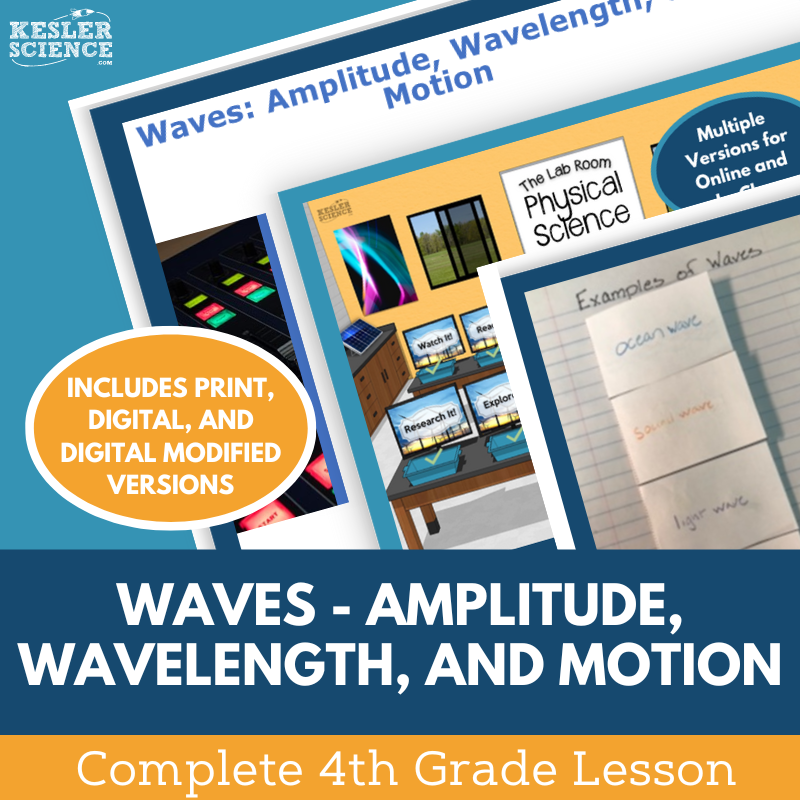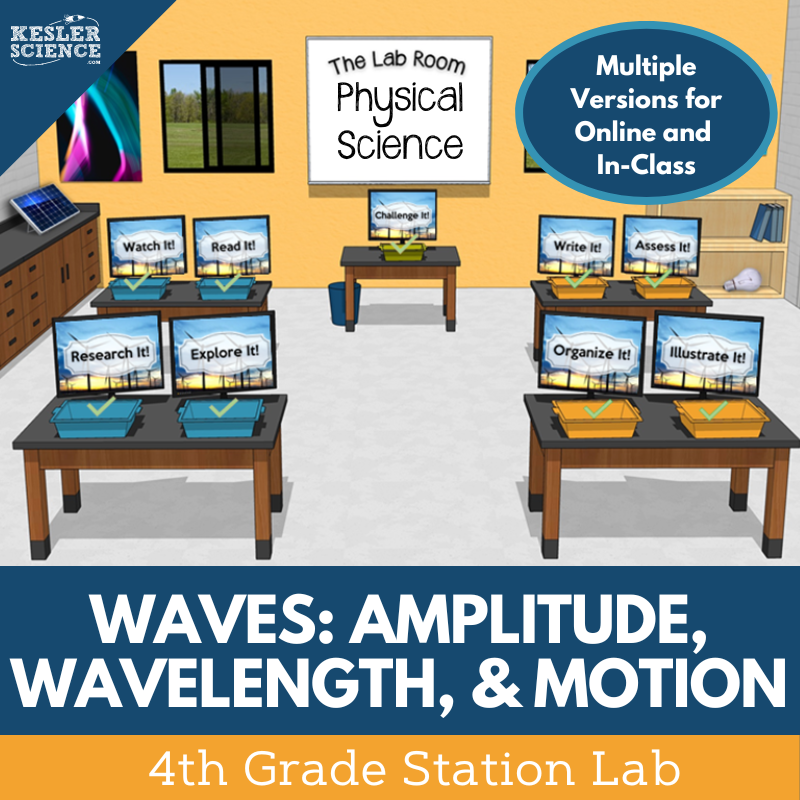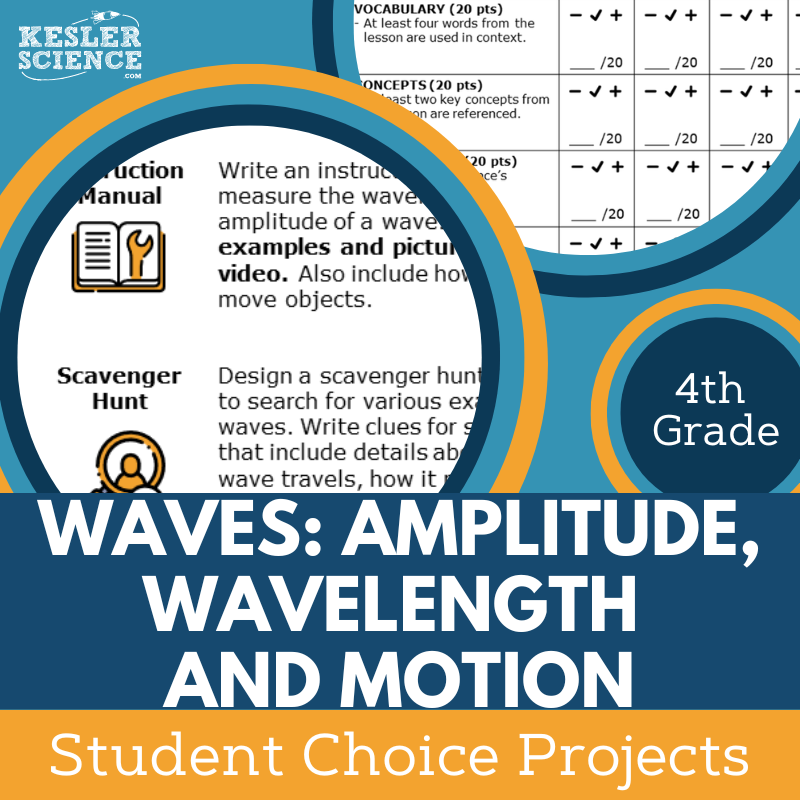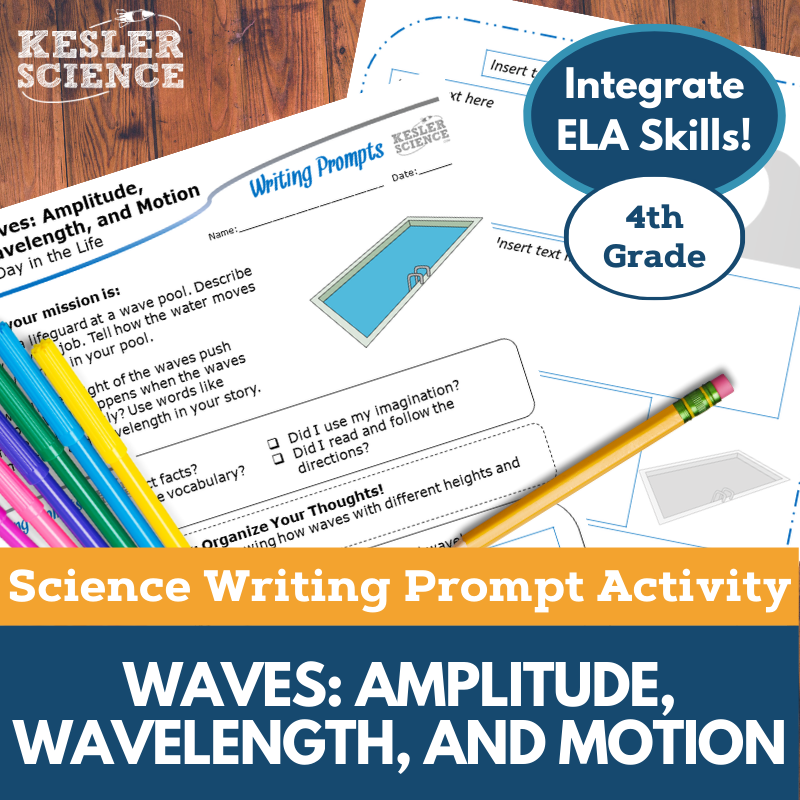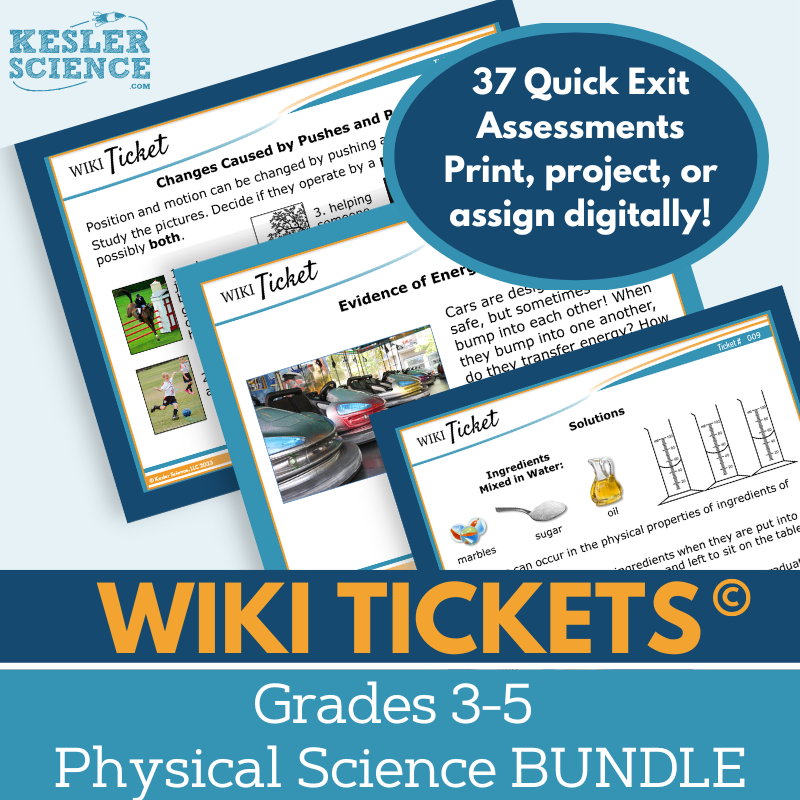Waves Activities for 4th Grade Science
The Kesler Science Waves – Amplitude, Wavelength, and Motion resources provide 4th grade students with hands-on, student-led activities to explore wave patterns and movement. The resources below will give students a comprehensive understanding of waves. All of the following materials are also included in the Kesler Science Membership.
The Kesler Science Waves – Amplitude, Wavelength, and Motion 4th Grade Complete 5E Lesson provides everything needed for a multi-day, student-led exploration of wave patterns and movement. Engaging and low-prep, this lesson encourages students to develop models, analyze wave behavior, and demonstrate understanding through hands-on and digital activities.
Built around the 5E Model, the lesson includes vocabulary word walls, discussion prompts, differentiated reading passages, and a nine-station lab covering exploration, research, writing, illustration, and assessment. Editable PowerPoints and interactive notebooks provide flexibility, while student-choice projects extend learning beyond the classroom.
Designed for print or digital use, this complete lesson includes assessments, review materials, and Spanish translations, making it adaptable for in-person or virtual learning.
The Kesler Science Waves – Amplitude, Wavelength, and Motion 4th Grade Complete 5E Lesson provides everything needed for a multi-day, student-led exploration of wave patterns and movement. Engaging and low-prep, this lesson encourages students to develop models, analyze wave behavior, and demonstrate understanding through hands-on and digital activities.
Built around the 5E Model, the lesson includes vocabulary word walls, discussion prompts, differentiated reading passages, and a nine-station lab covering exploration, research, writing, illustration, and assessment. Editable PowerPoints and interactive notebooks provide flexibility, while student-choice projects extend learning beyond the classroom.
Designed for print or digital use, this complete lesson includes assessments, review materials, and Spanish translations, making it adaptable for in-person or virtual learning.
The Kesler Science Waves - Amplitude, Wavelength, and Motion Station Lab immerses 4th grade students in hands-on, student-led learning. This engaging lesson saves prep time while providing differentiated, multimodal activities that allow students to develop models of waves, describe patterns, and explore how waves cause movement.
With nine modular stations, students engage in various input and output activities, including hands-on exploration, research, reading, video analysis, organization, writing, illustration, and assessment. A bonus challenge station extends learning for early finishers.
Designed for flexibility, this lab can be completed independently or in small groups using common classroom materials. Printable and digital options ensure seamless integration into both in-person and virtual learning environments.
The Kesler Science Waves - Amplitude, Wavelength, and Motion Station Lab immerses 4th grade students in hands-on, student-led learning. This engaging lesson saves prep time while providing differentiated, multimodal activities that allow students to develop models of waves, describe patterns, and explore how waves cause movement.
With nine modular stations, students engage in various input and output activities, including hands-on exploration, research, reading, video analysis, organization, writing, illustration, and assessment. A bonus challenge station extends learning for early finishers.
Designed for flexibility, this lab can be completed independently or in small groups using common classroom materials. Printable and digital options ensure seamless integration into both in-person and virtual learning environments.
The Kesler Science Waves, Amplitude, Wavelength, and Motion Student Choice Projects empower 4th grade students to demonstrate their understanding in a way that fits their learning style. With six project options and a “design your own” choice, students take ownership of their learning while using a teacher-provided rubric for self, peer, or teacher assessment.
These flexible, multimodal projects allow for differentiation, with a modified version targeting students needing extra support. Teachers can easily adapt the editable rubric to fit their grading needs, ensuring all students can succeed at their level.
Using common classroom supplies, these projects can be completed with paper, markers, and scissors or digitally for added versatility. Whether used for enrichment, differentiation, or independent learning, these student-led projects make science engaging and personalized.
The Kesler Science Waves, Amplitude, Wavelength, and Motion Student Choice Projects empower 4th grade students to demonstrate their understanding in a way that fits their learning style. With six project options and a “design your own” choice, students take ownership of their learning while using a teacher-provided rubric for self, peer, or teacher assessment.
These flexible, multimodal projects allow for differentiation, with a modified version targeting students needing extra support. Teachers can easily adapt the editable rubric to fit their grading needs, ensuring all students can succeed at their level.
Using common classroom supplies, these projects can be completed with paper, markers, and scissors or digitally for added versatility. Whether used for enrichment, differentiation, or independent learning, these student-led projects make science engaging and personalized.
The Kesler Science Waves: Amplitude, Wavelength, and Motion Writing Activity engages 4th grade students in exploring wave patterns through a creative "day in the life" writing prompt. This integrated science and ELA activity strengthens scientific reasoning while encouraging students to express their understanding in a fun and meaningful way. Designed for flexible learning, it supports both in-class and virtual instruction.
This student-centered resource is aligned with TEKS and NGSS, making it ideal for elaboration, review, or cross-curricular connections. The activity includes teacher directions, answer guides, project ideas, and rubrics in both full-sheet and half-sheet formats. Students can work on printable handouts or complete assignments digitally using PowerPoint or Google Slides.
With multiple uses, this writing prompt can serve as a pre-test, differentiation exercise, extra credit, or a TELPAS writing sample. Whether used for early finishers or student choice projects, this low-prep, high-quality activity enhances science literacy while keeping students engaged.
The Kesler Science Waves: Amplitude, Wavelength, and Motion Writing Activity engages 4th grade students in exploring wave patterns through a creative "day in the life" writing prompt. This integrated science and ELA activity strengthens scientific reasoning while encouraging students to express their understanding in a fun and meaningful way. Designed for flexible learning, it supports both in-class and virtual instruction.
This student-centered resource is aligned with TEKS and NGSS, making it ideal for elaboration, review, or cross-curricular connections. The activity includes teacher directions, answer guides, project ideas, and rubrics in both full-sheet and half-sheet formats. Students can work on printable handouts or complete assignments digitally using PowerPoint or Google Slides.
With multiple uses, this writing prompt can serve as a pre-test, differentiation exercise, extra credit, or a TELPAS writing sample. Whether used for early finishers or student choice projects, this low-prep, high-quality activity enhances science literacy while keeping students engaged.
The Kesler Science Physical Science WIKI Tickets provide engaging formative assessments for 3rd–5th grade science. This set includes 37 exit tickets aligned to NGSS and TEKS, covering chemistry, energy, force, and motion topics.
Each assessment comes in five formats: a full-screen display for projection, three printable handout sizes, and an interactive digital version compatible with PowerPoint and Google Slides. A table of contents file ensures easy standard alignment.
WIKI Tickets (“What I Know Is”) serve as exit tickets, bellringers, or quick checks for understanding, making them a versatile tool for both in-person and virtual learning environments.
The Kesler Science Physical Science WIKI Tickets provide engaging formative assessments for 3rd–5th grade science. This set includes 37 exit tickets aligned to NGSS and TEKS, covering chemistry, energy, force, and motion topics.
Each assessment comes in five formats: a full-screen display for projection, three printable handout sizes, and an interactive digital version compatible with PowerPoint and Google Slides. A table of contents file ensures easy standard alignment.
WIKI Tickets (“What I Know Is”) serve as exit tickets, bellringers, or quick checks for understanding, making them a versatile tool for both in-person and virtual learning environments.
Year-Round Resources
These year-round activities will increase your students' understanding of many middle school science topics. All of these activities are also included in the Kesler Science Membership.
Visual Data & Graphing
You're not alone if your students struggle with understanding graphs, charts, and tables. It's a skill that takes an enormous amount of practice. This resource will help students build a strong foundation in analyzing data and creating their own data visualizations.
Bell Ringers and Warm-Ups
These middle school science bell ringers are an excellent way to engage your students as soon as they walk into your classroom. This comprehensive FULL YEAR resource includes everything you need to start off each science class with an interesting warm-up activity.
Review Board Games
Each game board has been carefully designed to keep students engaged. There are 10 different action spaces on each board and dozens of question cards. All of the actions are related to science concepts and keep the students motivated throughout the game.
Each game is ready to play. Simply print out the board and the cards and let the students enjoy reviewing nine different units.
Essential Questions
Below are the essential questions associated with the lessons and activities included in this unit. This topic is only one of more than 100 middle school science topics included in the Kesler Science Membership.
-
How can we model the similarities and differences between waves?
-
What evidence shows that waves can cause objects to move?
Kesler Science Membership
Imagine never having to search for another middle school science lesson again. The membership gives you access to ALL of the Kesler Science products in one place (Yes, including everything above).
Say goodbye to long hours of lesson prep.

